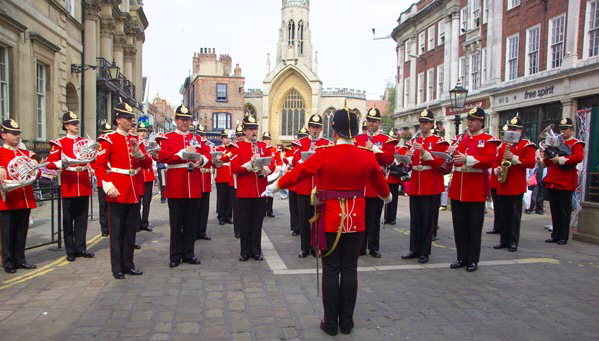There were two things of interest to be heard yesterday -- Holst's Suite for Military Band at Knellar Hall and Brahm's Third Symphony at Queens Hall...
--editorial in The Times (London), 16 Sept. 1920.1
For almost two hundred years England was devoid of any native-born composer who held international respect. Indeed, from the death of Henry Purcell until the rise of Sir Edward Elgar the music scene in England represented little more than a copy of styles found on the European continent. Finally at the beginning of the 20th century, a renaissance of composition developed that would have a profound impact on English music. While some English composers (notably Elgar) continued to write in the German Romantic style, two introspective elements led to a new composition practice.
First, there was a fascination for the rich musical heritage present in England during the Elizabethan era--an era whose composers wrote in a compelling blend of polyphony and modality. Emphasizing both vocal and keyboard compositions, these composers included Thomas Tallis, William Byrd, Thomas Wilkes, Giles Farnaby, and Orlando Gibbons.
The second element was a keen interest in the study of English folk song. The craft of folk singers was preserved not only on paper, but also on wax cylinders, a practice that for the first time preserved performances for repeated listening. This interest in folk songs could not have come at a better time, as folk singers and their craft were rapidly disappearing. Just as research in this area was going on in Scandinavia with Edvard Grieg, and in Hungary with Bela Bartok and Zoltan Kodaly, so also in England people scoured the countryside, eagerly pursuing the roots of English music. Among these were Cecil Sharpe, Gustav Holst, Ralph Vaughan Williams, and a transplanted Australian named Percy Grainger. This stimulus provided the necessary focus for a British sound--a style of composition whose quality was in sharp contrast to the schools of influence led by Schoenberg and Stravinsky. Throughout the 20th century, music with a tonal center has not been far from the hearts of British composers.
GUSTAV HOLST
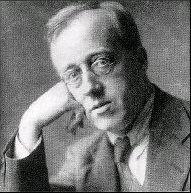
Gustav Holst 2Gustav von Holst (the "von" was dropped during World War I) had eclectic musical tastes which early on were influenced by Wagner's music, but later led him not only to explore folk song, but even to write several pieces inspired by the Hindu culture. As a young man Holst had to give up keyboard performance because of neuritis in his right hand, so he earned his livelihood playing trombone in opera orchestras such as the Scottish Orchestra, and at engagements at summer resorts. Holst abandoned the trombone by 1903 and began to make his living as both a teacher and composer.
First Suite in E-flat
It was during this time that efforts were begun to encourage England's best composers to write new, serious literature for the military band. Holst, who was no stranger at Knellar Hall (the military band school), was among those approached. So in 1909 Holst relied on his expertise as a wind player and wrote the first of two suites for band. His daughter Imogen Holst explains:
The lessons he had learnt in writing for children and amateurs proved helpful in his works for military band. Here his players were highly skilled experts as far as their instruments were concerned, but the music they played had to be simple and economical. The First Suite in E-flat was an experiment in form, each movement being founded on a fragment of the opening Chaconne . . . The whole suite is superbly written for military band, especially the scherzando variation in the Intermezzo which exactly suites the brittle texture of the woodwind. It must have been a startling change from the usual operatic selections, and there are bandsmen who still remember the excitement of the first rehearsal in 1909. In spite of its original approach, the Suite never breaks away from the essential traditions of the band, and the March is the sort of music that is beloved of bombardons and euphoniums. It was not for nothing that Holst had played trombone on the pier in his student days: when he opens out into an inevitable meno mosso, it is with the assurance if an experienced bandsman who knows exactly what the other players are going to enjoy.2
piccolo in D-flat
2 E-flat clarinets
2 oboes
B-flat clarinets
(solo 1,2,3)
alto saxophone
tenor saxophone
2 bassoons
4 E-flat horns
B-flat cornets
(solo 1,2)
2 B-flat trumpets
3 trombones
euphonium
tubas
timpani
snare
bass drum
cymbals
triangle
tambourine
Instrumentation for
First Suite in E-flat
by Gustav Holst
The First Suite in E-flat became the cornerstone for twentieth century band music. The simple, straightforward craft of Holst blended elements of traditional form (Chaconne, Intermezzo) with elements familiar to the British band heritage (March) to create one of the most frequently played concert pieces ever written for band. The first four notes provide the motive for all the subsequent melodic material, providing a cohesiveness and stylistic maturity seldom found in previous band literature.
Here was a piece that provided an alternative to the operatic transcriptions, simple marches, and period pieces that had provided the bulk of the band literature to date. While the original scoring was typical of the British military band, publishers expanded the instrumentation to fit American bands as observed in the first full score printed in 1948.
Premiere of the 1st Suite in E-flat
Curiously, approximately eleven years elapsed between writing the Suite in E-flat and its first known concert performance. The same is true of the Suite in F. There is only speculation surrounding the date and circumstances of the first performance of the Suite in E-flat. Imogen Holst suggests that it could have been written for a special occasion such as the Festival of the People's Palace, in Mile End, London, in May of 1909.
The first documented concert performance of the Suite in E-flat took place at Kneller Hall on June 23, 1920. During the subsequent playing season the suite had numerous performances, receiving somewhat remarkable coverage in various newspapers. One account in the Times listed it in the same breath as Brahms' Third Symphony:
There were two things of interest to be heard yesterday -- Holst's Suite for Military Band at Knellar Hall and Brahm's Third Symphony at Queens Hall...3
The Richmond Times listed the following account of a performance:
...a notable contribution was Gustav Holst's Suite in E-flat, a virile and arresting composition. Mr. Holst, who is a force to be reckoned with in modern music, takes a keen interest in the work at Kneller Hall to the extent of personal visits when any of his music is being rehearsed for performance.4
It is curious how a work of such merit could go unnoticed for so long. Perhaps old traditions truly die hard. The force behind this and subsequent performances of both of Holst's suites was Col. J.A.C. Somerville who was commandant from 1920 to 1925 of the Royal Military School of Music at Kneller Hall, Twickenham, England. This was the training school for all bandsmen in the British army.
Second Suite in F
Reflecting his interest in folk song, two years after composing the First Suite in E-flat Holst took up pen and wrote the Second Suite in F, founding it on Hampshire folk songs. Set in four contrasting movements, he deftly applied his trade to a number of songs such as "Swansea Town", "I'll Love My Love," and "The Song of the Blacksmith". In the last movement he created the memorable combination of two folk songs heard simultaneously, the revolving "Dargason" and the classic "Greensleeves". This engaging combination also found its way into the last movement of his St. Paul's Suite for strings.
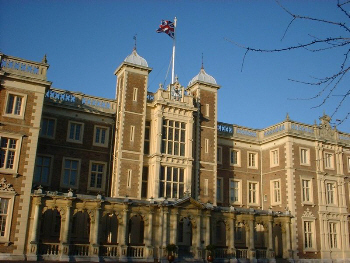
Kneller Hall, home of the
Royal School of Military Music 3The Suite in F received its first public performance on June 22, 1922, at Albert Hall for the British Music Society's annual convention. Once again the Royal Military School of Music
gave the performance. A program note from this premiere suggests that Holst forgot about the work shortly after its composition:
This Suite the (Second Suite in F) was originally written in 1911, and then put aside and forgotten until recently when the composer was appealed to for a work for the military band, and its existence recalled . . .5
History owes a debt of gratitude to Somerville's interest in the literature for the wind band. His efforts to bring Holst's music to the fore provided the stimulus for other works which soon followed from the pen of Ralph Vaughan Williams, Gordon Jacob, and Haydn Wood.
Despite the delay in performance of these two suites, rest assured that they quickly gained in popularity, as noted in the program of a concert from 1925:
This suite was written by Mr. Holst, Alsop Lecturer at the University of Liverpool, and one of the foremost British composers, in response to the oft-expressed desire that first class composers would write direct for the military band. As it is, most of the military band repertoire consists of arrangements of orchestral music. Holst has written two suites for military band, and this one has become so popular that scarcely a night passes in the Summer without it being heard in the London parks by one or other of the leading military bands . . .6
Hammersmith
In 1927 the B.B.C. wrote Holst requesting a new piece for its military band. Holst was eager to accept the invitation, but requested to finish a band arrangement of Bach's Fugue in G Major (BWV 577), a work to be referred to as Fugue a la Gigue. Holst then arranged "Marching Song" from Two Songs Without Words, and the unfinished military band version of A Moorside Suite before tackling what would be his most formidable piece for military band, Hammersmith--Prelude and Scherzo.7 The piece is technically more challenging than earlier works, due no doubt to the expertise of the commissioning ensemble. Concerning Hammersmith, Imogen Holst writes:
The mood out of which the music had grown was a mood that had haunted him for nearly forty years: during his solitary walks in Hammersmith he had always been aware of the aloofness of the quiet river, unhurried and unconcerned, while just round the corner there was all the noise and hustle and exuberant vulgarity of the cockney crowd, pushing and shoving and sweating and swearing and shrieking and guffawing its goodhumoured way.8
Thus one understands the purpose behind the contrasting elements of the ground bass which opens the Prelude and the busy activity of the Scherzo. The commissioned performance never took place. Because of his death four years later, Holst never heard the music in its originally intended form (he did hear the transcription for orchestra before his death). It was finally published in 1956.
Ralph Vaughan Williams led a long and illustrious career as a composer. He and his close friend Gustav Holst were considered to be late bloomers in the field of composition, but once they reached maturity, both were active in composition to the end of their lives. Vaughan Williams outlived Holst by some twenty-four years.
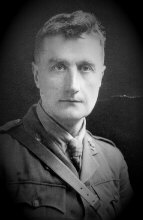
Ralph Vaughan Williams 4Having studied at Cambridge and the Royal Academy of Music, Vaughan Williams augmented his studies with work in the German Romantic school, studying with Max Bruch in Berlin, beginning in 1897. In 1908 he honed his orchestration skills while studying with the younger but more advanced Maurice Ravel in Paris. Ever aware of his slow pace to a mature level of composition, Vaughan Williams enjoyed a new stimulus when he joined the Folk-Song Society in 1904. As was the case with Holst, folk songs provided the impetus for a number of pieces, though personal interest led to further development of his own melodic and harmonic style. After World War I a new style developed which was influenced by music of the Elizabethan era of the late Renaissance, as mentioned earlier. This, in combination with his own stylistic traits, created such mystical works as the Third Symphony and The Lark Ascending.
English Folk Song Suite
Vaughan Williams' sense of nationalism and patriotism manifested itself in a variety of ways. In addition to examples such as the bugle call in the second movement of the Third Symphony are the pieces written after the war for military band. Having collected over 800 folk songs in his lifetime, it is not surprising that his first band piece was the English Folk Song Suite written in 1923.9 The suite was written for the Royal Military School of Music at Kneller Hall. According to Vaughan Williams' wife, he welcomed the opportunity to compose a piece for band.
A military band was a change from an orchestra, and in his not-so-far off army days he had heard enough of the "ordinary monger's light stuff" to feel that a chance to play real tunes would be an agreeable and salutary experience for Bandsmen.10
Vaughan Williams used no fewer than nine folk songs to create the three-movement suite.11
Sea Songs and Toccata Marziale
The following year Vaughan Williams wrote two more songs for military band. Sea Songs is a simpler, one-movement work incorporating the songs "Princess Royal", "Admiral Benbow", and "Portsmouth". Toccata Marziale, like the English Folk Song Suite, takes its place among the best literature for wind band. Composed for the Commemoration of the British Empire Exhibition, Toccata Marziale provides a different perspective to Vaughan Williams' compositional style. In contrast to the English Folk Song Suite it carries a powerful sound of contrasting masses of brass and woodwinds, supporting an engaging contrapuntal format projected through the use of major, minor, and whole tone scales.
Flourish for Wind Band
Finally, mention should be made of the Flourish for Wind Band, first performed in the Royal Albert Hall, London, on April 1, 1939. This simple yet elegant piece was composed as an overture to the pageant Music and the People.
Grainger on Folk Singers
Grainger championed the cause of the folksinger and bitterly denounced the manner in which they were treated as musical and social outcasts:
For these folksingers were kings and queens of song! No concert singer I have ever heard approached these rural warblers in variety of tone-quality, range of dynamics, rhythmic resourcefulness and individuality of style. For while our concert singers (dull dogs that they are--with their monotonous mooing and bellowing between mf and ff, and with never a pp to their name!) can show nothing better (and often nothing as good) as slavish obedience to the tyrannical behest of composers, our folksingers were lords in their own domain--were at once performers and creators.1
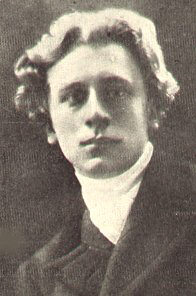
Percy Aldridge Grainger 5Because of the impact that English folk songs had on his career, Percy Grainger is included in the list of 20th Century English Renaissance composers. An eccentric personality to say the least, Grainger was a music figure of international renown. Born in Australia in 1882, his early piano training was with his mother and Louis Pabst prior to studying in Germany for six years. Upon receiving acclaim as a performer in London late in 1900, Grainger began a performance career that provided the opportunity to travel throughout the world. After making England home for some years, he came to America in 1915, and eventually became a citizen in 1919. Self-taught in composition, his style was one of innovation, using irregular meter, a wide variety of instrumental color combinations, and experimentation with electronic music.
Folk Song Influences
In addition to his masterful use of wind scoring, perhaps the most compelling aspect of Percy Grainger's music was his love of folk song. As an early musicologist, Grainger recorded many of the folk songs of England on the Edison wax cylinder phonograph. Indeed, at the turn of the century, folk singing was rapidly becoming a dying art, with a number of his singers being over eighty years old. As an avid collector of folk songs, he compiled songs not only in England, but also throughout the world. As a result, most of his compositions were either directly or indirectly influenced by folk music.
Grainger could transform a piece into something of a musical portrait of the individual singer who sang the song for him - his or her "regular or irregular wonts of rhythm", mixed with contrasts in style and "breadth or delicacy of tone".12 It was Grainger's purpose to recreate a folk song instrumentally in such a way as to retain the original character of the song as much as possible. That meant that songs would not be "cleaned up" and packaged into four measure phrases, etc., as many other so-called champions of folk song had done. Instead the rhythm, tempo, style, and dynamics transcribed from the song would reflect each inflection, verse by verse, which the singer had presented. The result for the music world was both fascinating and challenging.
Early Works
Grainger had been writing and honing his skills for many years preceding this. In fact his writing for bands preceded Holst by several years, though his music was slower in attracting the favor and attention of band conductors. The first Hill-Song was completed in 1902, while the Band of the Coldstream Guards performed the march Lads of Wamphray in 1905. These works were not published, however, until a later date, thus preserving the place of homage that Holst's First Suite in E-flat has held in the band world.
After moving to America Grainger's interest in band music was nurtured while serving as an Assistant Instructor at the Army Band School on Governor's Island during World War I. His earliest published band works date from the years 1917-1919, and include the folk song settings Shepherd's Hey, Molly on the Shore, Irish Tune from County Derry, and original works including Children's March, Over the Hills and Far Away, Gumsucker's March (both of these for band and piano) and Colonial Song.14
piccolo
2 flutes
2 oboes
English horn
2 bassoons
contrabassoon
E-flat clarinet
B-flat clarinet
(1st, 2nd, 3rd)
E-flat alto clarinet
B-flat bass clarinet
soprano saxophone
alto saxophone
(1st, 2nd)
tenor saxophone
baritone saxophone
bass saxophone |
cornet (1st, 2nd, 3rd)
or trumpet
horn (1st, 2nd, 3rd, 4th)
trombone (1st, 2nd)
bass trombone
baritone (treble clef)
euphonium (bass clef)
tuba
string bass
timpani
snare drum
bass drum
cymbals
glockenspiel
xylophone
chimes
Swiss hand bell |
Instrumentation for Lincolnshire Posy
by Percy Grainger |
Grainger held a particular love for the timbre of wind instruments. He was a continual experimenter in new sounds, and sometimes championed the sound of more obscure instruments. His attraction to the double reeds is evidenced in the Hill Songs, and he described the saxophone as being the most expressive of all the instruments as well as the one most nearly approximating the human voice. His love of color is most evident when the instrumentation of Lincolnshire Posy is compared with that of the Holst suites. Grainger used a fuller complement of clarinets and saxophones, and added mallet and tuned percussion.
Lincolnshire Posy
Grainger's use of folk song in composition is exemplified in his work Lincolnshire Posy. Written in six movements, Grainger's newest work surely stunned the band world in 1937--presenting challenges in timbre, style, and rhythm that were not normal fodder for band directors.13
Later Works
Among Grainger's other works scored for band are Spoon River (a setting of an American folk tune), Irish Tune from County Derry, The Immovable Do (1941), Marching Song of Democracy (1948), and a piece scored for band and organ called The Power of Rome and the Christian Heart.
Just as the military band was coming of age and maturity in Britain, the brass band continued its great popularity. The lack of English composers in the 19th century necessitated the playing of standards by other composers such as Mendelssohn, Schumann, Wagner, etc. After all, the raison d'être for the brass band was competition, so the level of performance was more important than the quality of music. This, coupled with the fact that the brass band phenomenon represented music for the lower and middle classes, discouraged original composition of much breadth. The 20th century renaissance of English music, coupled with the efforts of a few enlightened patrons, changed all the aforementioned. Beginning in the 1920s and 1930s some of the best-known English composers were commissioned to write "test pieces" for contests. These works were designed to fit certain contest criteria, and would be performed by all entering bands.
Oddly enough, the English interest in composition for military band in the early decades for the most part did not sustain itself during the rest of the 20th century (one notable exception being Gordon Jacob). This observation is made in contrast to the great interest in writing for bands so prevalent in the United States today. Perhaps one reason was the great interest that Britain retained in the brass band - a phenomenon that disappeared in America soon after the close of the Civil War. The American concert band, with part of its roots in the British military band, has been a primary musical outlet for both the military and the general public, first through the professional band and then through the school band movement. By contrast, the British military band, with its woodwinds and brass, has served a different function from that of the brass band, which is more of a social event. Indeed, it has been observed that the quality of performance of the military bands has often been inferior to that of the brass bands. British composers have apparently considered the wind band to be lower than the brass band in the musical pecking order, and have been concerned that a performance of a work can potentially be subject to a myriad of instrumental doublings.15
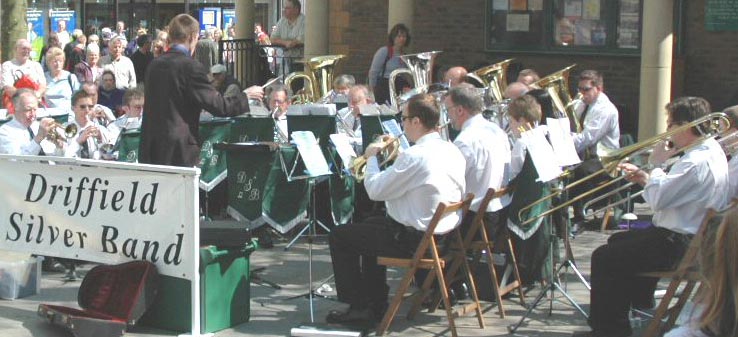
The Driffield Silver Brass Band performs at an outdoor gathering 6CONCLUSION
The impact of English composition early in the 20th century on the literature of the wind band has been most significant. Despite the relative drought of composition over numerous decades, there has been an effort in recent years to encourage British composers of some note to write with the military or wind band in mind. Included in this newer group are Timothy Reynish, Thea Musgrave, Alun Hoddinott, Edward Gregson, David Bedford, Derek Bourgeois, Stephen Dodgson, Philip Sparke and Adam Gorb, to name several. The result is a new body of literature that will make its mark on the band movement for years to come.
ENDNOTES
1The Times (London), "An Orchestra and a Military Band: Brahms and Holst", September 16, 1920.
2Imogen Holst, The Music of Gustav Holst, 2nd ed. (London: Oxford University Press, 1968) p. 33.
3The Times (London), "An Orchestra and a Military Band: Brahms and Holst," September 16, 1920.
4Richmond Times, July 17, 1920.
5Programme note, British Music Society concert, Royal Albert Hall, June 30, 1922, quoted in I. Holst, A Thematic Catalogue..., p. 99.
6Jon C. Mitchell, From Kneller Hall to Hammersmith: The Band Works of Gustav Holst Alta Musica (Tutzing: Hans Schneider 1990) p. 17.
7Mitchell, p. 122.
8Holst, p. 125.
9Elliot Antokoletz, Twentieth-Century Music, (Englewood Cliffs, New Jersey: Prentice Hall, 1992) p. 162.
10Ursula Vaughan Williams, Ralph Vaughan Williams, A Biography of Ralph Vaughan Williams (London: Oxford University Press, 1964) p. 150-153.
11The folk songs included: March - "Seventeen Come Sunday", "Pretty Caroline", and "Dives and Lazarus"; Intermezzo - "My Bonny Boy" and "Green Bushes"; Folk Songs from Somerset - "Blow away the Morning Dew", "High Germany", "The Tree so High", and "John Barleycorn".
12Program notes written by Grainger for the score to Lincolnshire Posy (London: Schott & Co., 1940) p. 1.
13An explanation of the first performances of Lincolnshire Posy is found in BDGuide, March-April 1990, p. 44-45.
14Richard Franco Goldman, The Wind Band, (Boston: Allyn and Bacon, Inc., 1961) p.225.
15Timothy Reynish, "New Works For Wind Band," Composer 79 (Summer 1983) pp. 2-3.
SIDEBAR NOTE
1Program notes written by Grainger for the score to Lincolnshire Posy (London: Schott & Co., 1940), p.1.
PICTURE CREDITS
1Photograph of the Band of the King's Division in York, taken by Ian Britton, 2006. Copyright 2006, Ian Britton, www.freefoto.com. Used by permission.
Source: http://www.freefoto.com/preview/11-20-22?ffid=11-20-22&k=Band+of+the+King%27s+Division.
2Photograph of Gustav Holst, photographer unknown. Public domain.
Source: http://commons.wikimedia.org/wiki/Image:Holst.jpg.
3Photograph of Kneller Hall, home of the Royal School of Military Music, taken by J. Miall, 2006. Released into public domain by photographer.
Source: http://commons.wikimedia.org/wiki/Image:Kneller_Hall_Whitton_Feb_2006.jpg.
4Photograph of Ralph Vaughan Williams, photographer unknown, c. 1918? From the web site www.stainer.co.uk/rvw.html. Used by permission.
Source: http://www.stainer.co.uk/images/rvw2.jpg.
5Photograph of Percy Grainger, photographer unknown. Public domain.
Source: http://commons.wikimedia.org/wiki/Image:PercyGrainger.jpg.
6Photograph of Driffield Silver Band, taken by Motters, 2004. Used by permission.
Source: http://en.wikipedia.org/wiki/Image:Brassband2.jpg.
|
